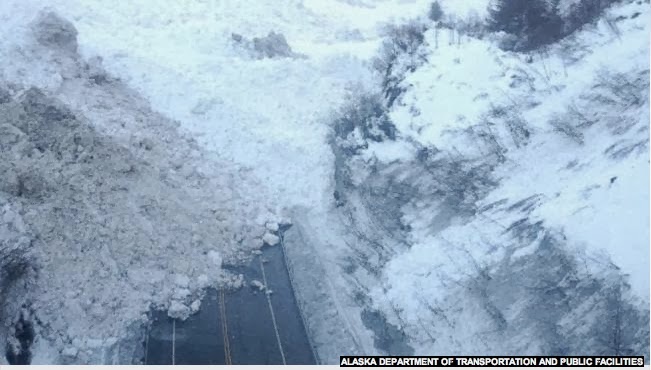 |
| The avalanche on Richardson Highway near Valdez Alaska Department of Public Transportation and Public Facilities |
 |
| Reuters photo from here. |
Last Friday avalanches ranging up to hundreds of feet in length and 30-40 feet in depth blocked the Richardson Highway leading to Valdez, Alaska, a town of 4,000 people. This highway connects Valdez to the rest of the Alaska Highway system (however, supplies can be brought into the town by ship.) An even larger avalanche occurred on Saturday, and a 50 mile stretch of highway has been closed (it is impressive that it takes the helicopter nearly two and a half minutes to fly the length of the impounded lake and avalanches.) Here's a great video, courtesy of Josh Miller and Douglas Fulton of Vertical Solutions, of a helicopter flyover of the avalanches and impounded use/debris/water lake. There is some hope of digging the residents out by tomorrow (Tuesday), but the city officials are asking residents to plan to be there at least a week. There are multiple avalanches across the highway.
One potentially serious problem is that one of the slides created a snow dam in Keystone Canyon that has impounded the Lowe River, and although some of the water is draining through an old railway tunnel, the potential for an ice-dammed lake breaking is real. The Alaska Department of Transportation says that it is too dangerous to work on clearing the slide until the lake drains because of fears that digging on the downstream side could trigger a surge of water. The National Weather Service issued a flood watch on Monday for residents downstream of the ice dam, saying that the ice dam could collapse with "little or no warning."
According to the Alaska Avalanche Information Center more than 3" of rain on 24 hours, combined with abnormally high (above freezing) temperatures over the past 10 days caused conditions conducive to avalanching. Some reports suggest water up to 40' deep behind the ice dam.
Much is being made of the fact that Valdez is much warmer than the mid-section of the US, currently experiencing another Arctic blast. Valdez has been in the 40's, and some parts of Alaska could even be in the lower 60's this week. Spring has, simply, started early in Alaska.











No comments:
Post a Comment